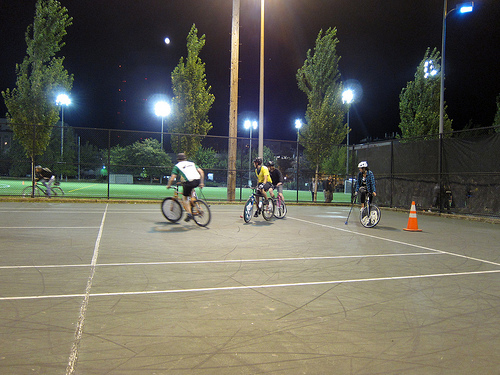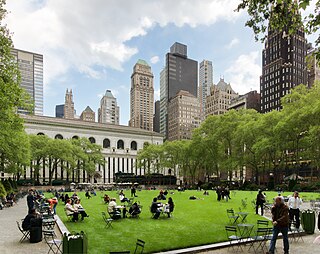
bike polo. Attributed to: Sean Munson – license – original
According to a recent study published in the Journal of Environmental Science and Technology, moving to an area with more green space might have a lasting positive impact on people’s mental health. This finding is the latest data point in the ongoing controversy about urban parks.
Wait—controversy? What could be controversial about parks? Parks let us connect with nature; give children a place to play; clean the air. They’re a refuge from noxious noises and fumes and crowds. They’re the ultimate urban amenity. Right?
Well, maybe not. Here’s what Jane Jacobs, patron saint of the modern urbanist movement, has to say about parks:
“Parks are volatile places. They can be delightful features of city districts, and economic assets to their surroundings as well, but pitifully few are. They can grow more beloved and valuable with the years, but pitifully few show this staying power. For every Rittenhouse Square in Philadelphia, or Rockefeller Plaza or Washington Square in New York, or Boston Common, or their loved equivalents in other cities, there are dozens of dispirited city vacuums called parks, eaten around with decay, little used, unloved.” — (Death and Life of Great American Cities, p. 89)
No one has ever accused Jane Jacobs of burying the lede.
Of course, Jacobs would not write a 22-page chapter just to say that parks are bad. But her opening polemic is a blunt reminder that good design is just as important for open spaces as it is for structure. A well-designed park or playground can be the highlight of a neighborhood; a poorly-designed one can drive away visitors and destroy street life.
Bryant Park, in New York City, is a textbook example of the effect that park design can have on a neighborhood. In the 1970s and 1980s, Bryant Park was patronized primarily by drug dealers and other criminals. In 1988, the park was closed for a four-year renovation project. When the park reopened in 1992, it bore little resemblance to the “Skid Row park” that had been there before. The old park was elevated and separated from the street with tall hedges; the redesign brought the park down to street level and opened up the borders. In place of graffiti and broken facilities, there was high-quality lighting, public bathrooms, and movable chairs (to give patrons a sense of control and ownership). The park’s private managers created a busy schedule of events, ensuring a constant flow of visitors.

Bryant Park, today. Attributed to: Jean-Christophe BENOIST – license – original
Not every park can be award-winning. But there is a lot to learn from Bryant Park’s success, and we can apply those lessons to nearly every green space that we create.
- Permeability: Cities work best when they encourage movement. A large, blank building facade is the surest way to discourage pedestrian activity on a given block. The isolation provided by walls and hedges is just as useful for committing crime as it is for enjoying nature (if not more so). A street magician performing behind a hedge will have trouble attracting an audience; the same magician, performing on a wide-open plaza, will easily draw a crowd from the nearby streets.
- Site: Like buildings and streets, the best parks are well-sited, and make the most of their location and site condition. A park on a steep hill would be a terrible place for a tennis court, but an excellent place for a rain garden or a “skate dot”.
- Activity: Knick-knack shops are cute, but there is a reason that they often have trouble staying in business; people just don’t buy knick-knacks as often as they buy food. The best parks provide unique physical spaces or host popular events. As an example, Cal Anderson Park on Broadway is home to the city’s only bicycle polo court, keeping the park active late into the evening.
- Biology: People need to eat. They need to urinate. They don’t want to stand up for hours. The best parks will provide food, restrooms, chairs, and benches. Without these “amenities”, people simply won’t stay as long.
Green space is a vital public amenity in dense cities. But in our zeal to make cities more livable, we must remember that good design always matters.
Aleksandra (Aleks) is a software engineer who moonlights as a writer and copy editor. Aleks's love of cities started as a child, when she would ride the commuter rail into Boston with her family for day trips. Her mission is to share that love with the world, by ensuring that our cities have a place for everyone. Aleks primarily writes about transportation and land use. She is also the webmaster.



